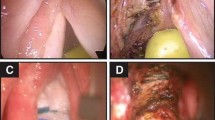Abstract
Our study was performed with an aim to analyse the factors responsible for the formation of a carbon granuloma (CG) following transoral laser microlaryngeal cordectomy (TLMC) for early glottic carcinoma. Our study comprises of retrospective data analysis of 78 patients who underwent TLMC for early glottic carcinoma between 2012 and 2017 with the laser settings of an acublade with scanning system, size 1–2 mm, depth 1–3 (250–750 μm), power 10 watts in a repeat mode with time off 0.25 s. A total of 19 patients had undergone type 1 cordectomy, 38 patients a type 2 cordectomy, 20 patients a type 3 cordectomy and 1 type 4 cordectomy. In the follow-up period, patients were divided into two groups—group A, who healed well and group B, who developed a CG. Both groups were analysed based on surgical factors (type of cordectomy, postoperative surface of vocal fold and cautery use) and healing factors (presence of diabetes mellitus and laryngopharyngeal reflux). Of 81 cordectomies, 15 (18.5%) developed a CG at an average period of 4 weeks postoperatively. All 15 patients were managed medically and by 4–8 weeks, 13 carbon granulomas resolved. Surgical excision in 2 patients who did not improve revealed granulation tissue. Of 40 type 2 cordectomies, 9 developed a CG (22.5%); of 20 type 3 cordectomies, 5 developed a CG (25%) and the 1 patient of type 4 cordectomy developed a CG (100%). Patients with cautery use, diabetes mellitus (DM) and laryngopharyngeal reflux (LPR) had a higher rate of CG formation. To summarise, in our study, a CG developed in 18.5% of our TLMC patients at an average postoperative duration of 4 weeks. An algorithm for treating and preventing this type of lesion is recommended.







Similar content being viewed by others
References
Chauhan JPS, Bharti B, Bhadouriya SS, Kumar A, Narain P, Singh J (2018) Laryngeal cancer: a clinicopathological study of 65 cases. Indian J Otolaryngol 4:163–168
Bobdey S, Jain A, Balasubramaniam G (2015) Epidemiological review of laryngeal cancer: an Indian perspective. Indian J Med Paediatr Oncol 36:154–160
Sharma DK, Sohhal BS, Bal MS, Agrawal S (2013) Clinicopathological study of 50 cases of tumors of larynx. Indian J Otolaryngol Head Neck Surg 65:29–35
Lin JRJ, Prisman E (2014) Transoral laser microsurgery for early glottic carcinoma. Surgery Curr Res 4(5):201–205
Bocciolini C, Presutti L, Laudadio P (2005) Oncological outcome after CO2 laser cordectomy for early stage glottic carcinoma. Acta Otorhinolaryngol Ital 25:86–93
Strong MS (1975) Laser excision of carcinoma of the larynx. Laryngoscope 85:1286–1289
Steiner W (1988) Experience in endoscopic laser surgery of malignant tumours of the upper aero-digestive tract. Adv Otorhinolaryngol 39:135–144
Steiner W (1993) Results of curative laser microsurgery of laryngeal carcinomas. Am J Otolaryngol 14:116–121
Feng Y, Wang B, Wen S (2011) Laser surgery versus radiotherapy for T1-T2N0 glottic cancer: a meta-analysis. ORL J Otorhinolaryngol Relat Spec 73:336–342
Gregorie V, Hamoir M, Rosier JF, Counhoy H, Eeckhoudt L, Neymark N, Scalliet P (1999) Cost minimization analysis of treatment options for T1N0 glottic squamous cell carcinoma: comparison between external radiotherapy, laser microsurgery and partial laryngectomy. Radiother Oncol 53:1–13
Remacle M, He E, Antonelli A, Brasnu D, Chevalier D, Friedrich G, Olofsson J, Rudert HH, Thumfart W, de Vincentis M, Wustrow TP (2000) Endoscopic cordectomy: a proposal for a classification by the working committee, European laryngeal society. Eur Arch Otorhinolaryngol 257:227–231
Davis RK, Jako GJ, Hyams VJ, Shapshay SM (1982) The anatomic limitations of CO2 laser cordectomy. Laryngoscope 92:980–984
Belafsky PC, Postma GN, Koufman JA (2002) Validity and reliability of the reflux symptom index (RSI). J Voice 16:274–277
Adams D (1976) The granulomatous inflammatory response- a review. Am J Pathol 84:164–191
Ansari MA, Erfanzadeh M, Mohajerani E (2013) Mechanisms of laser-tissue interaction: II. Tissue Thermal Properties. J Lasers Med Sci 4:99–106
Mckenzie AL (1983) How far does thermal damage extend beyond the surface of CO2 laser incisions? Phys Med Biol 28:905–912
Betlejewski S, Sinkiewicz A, Mackiewicz H, Owczarek A, Dalke K (2005) Carbon granuloma- an unwanted effect of laryngeal laser micro surgery. Pol Merkur Lekarski 19:417–419
Ertas B, Ismet EE, Aksoy A, Ulubil A, Guvenc MG, Tanyeri H, Unal OF (2017) Post endolaryngeal laser surgery carbon granuloma. Med Bull Haseki 55:137–141
Brem H, Tomic-Canic M (2007) Cellular and molecular basis of wound healing in diabetes. J Clin Invest 117:1219–1222
Rosenberg CS (1990) Wound healing in patients with diabetes mellitus. Nurs Clin N Am 25:247–261
Lan CC, Wu CS, Huang SM, Wu IH, Chen GS (2013) High glucose environment enhanced oxidative stress and increased interleukin-8 secretion from keratinocytes. Diabetes 62:2530–2538
Andrea MC, Jaqueline P, Rebecca HT, Tatiana M, Aida RA (2014) Laryngopharyngeal reflux: diagnosis, treatment and latest research. Int Arch Otorhinolaryngol 18:184–191
Bove MJ, Rosen C (2006) Diagnosis and management of laryngopharyngeal reflux disease. Curr Opin Otolaryngol Head Neck Surg 14:116–123
Author information
Authors and Affiliations
Corresponding author
Ethics declarations
Conflicts of interest
The authors declare that they have no conflict of interest.
Ethical approval
Required ethical approval taken from Bombay Hospital Ethics Approval Committee.
Informed consent
Application for waiver of consent form given to the Bombay Hospital Ethics Committee and approved since our study is a retrospective observational study.
Additional information
Publisher’s note
Springer Nature remains neutral with regard to jurisdictional claims in published maps and institutional affiliations.
Rights and permissions
About this article
Cite this article
Nerurkar, N.K., Shah, R. Factors responsible for the development of carbon granuloma post transoral laser cordectomy. Lasers Med Sci 34, 1383–1389 (2019). https://doi.org/10.1007/s10103-019-02726-3
Received:
Accepted:
Published:
Issue Date:
DOI: https://doi.org/10.1007/s10103-019-02726-3




